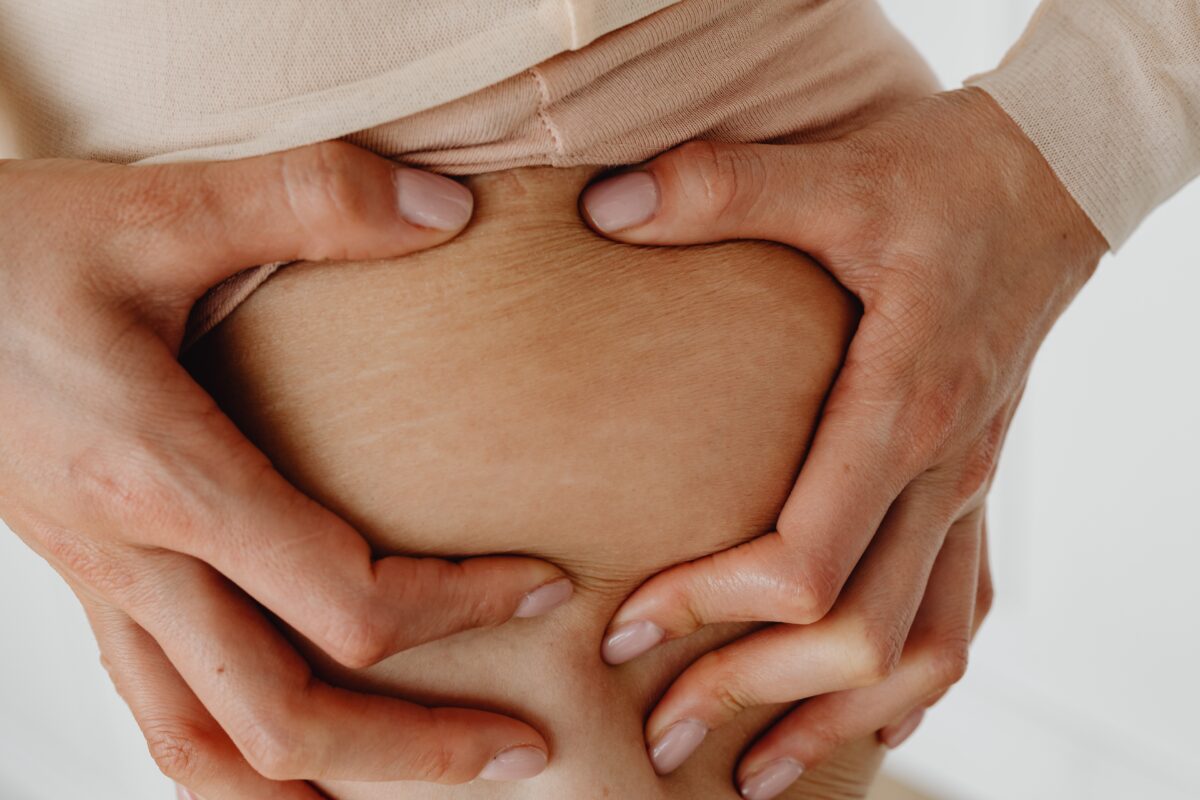A Deep Dive into Genetic Predisposition for Stretch Marks
Aira
on
September 20, 2023

Table of Contents
A Deep Dive into Genetic Predisposition for Stretch Marks
Date of Content: September 19, 2023
Written by: Avanthika Nityanand
Reviewed by: Maarit Tiirikainen, PhD
Overview
Stretch marks, scientifically known as striae are a widespread skin issue that initially manifests as colored lines and later turns white.

How Are Stretch Marks Caused?
When your skin undergoes quick changes in size—such as stretching or shrinking— its components, particularly elastin and collagen, are stretched.
Elastin is primarily responsible for allowing your skin to stretch, while collagen provides the skin with structure, strength, and support. When these fibers endure rapid changes, they can break or become damaged. As your skin goes through the natural healing process to repair this damage, stretch marks can form in the areas where the elastin has broken. These marks act as scars, revealing where the structural fibers of the skin have been compromised.
Hormones like cortisol also play a role in the formation of stretch marks. Elevated cortisol levels can weaken the skin’s elasticity and contribute to the development of stretch marks. Hence, they commonly occur during life stages associated with hormonal changes, such as puberty, pregnancy, or when undergoing specific medical treatments like prolonged application of corticosteroid creams.
Prevalence
The prevalence of stretch marks varies widely depending on the studied population. Estimates suggest that about 50% to 80% of people experience stretch marks at some point. Factors like age, gender, and life events such as pregnancy can influence the likelihood of developing stretch marks. They are a common skin condition and can occur in both men and women. However, stretch marks are more frequently reported in women.
Are Stretch Marks Genetic?
A couple of single-gene connective tissue disorders, such as Marfan syndrome, have been identified as related to the appearance of stretch marks. These conditions result from gene mutations that affect specific proteins in the extracellular matrix (a network of proteins and carbohydrates that provide structure and support to cells in tissues) that form part of the skin’s tiny elastic fibers (elastic microfibrils) and other tissues.
However, no known genetic variants were linked to the isolated occurrence of stretch marks in the broader population until this 2013 genome-wide association study by 23andMe. The main polymorphisms uncovered in this study are listed below.
ELN Gene
The ELN gene codes for the protein elastin, a key component in elastic fibers. Elastin fibers are protein strands that give connective tissues, like skin and ligaments, their flexibility and resilience. The final, stable form of the protein elastin, which gives tissues like skin and blood vessels their ability to stretch and return to their original shape, is called mature elastin.
Variations in the ELN gene can reduce the formation of mature elastin, contributing to certain conditions with stretch marks being a potential outcome. The ELN gene SNP most closely linked to stretch marks is rs7787362.
SRPX and HMCN1 Gene
The second significant association, rs35318931, is a missense alteration that changes serine to phenylalanine in the SRPX gene (sushi-repeat containing protein, X-linked) gene. The SRPX gene is associated with retinitis pigmentosa. However, the exact role of this gene with stretch marks is not well understood.
The third significant variant is rs10798036 in the HMCN1 (hemicentin-1) gene. Gene variants in the HMCN1 gene have been previously found to be related to age-related macular degeneration.
TMEM18 Gene
The SNP highlighted for the TMEM18 gene is rs7594220. This gene codes for the Transmembrane protein 18 and is known for its roles in neural stem cell migration, cancer, and obesity-related traits. Even that its role in stretch mark formation is unknown, the study found that this SNP is statistically significant on a genome-wide level, suggesting a strong likelihood that it is associated with stretch marks.
Which of the above gene variants do you have? Get the LifeDNA Skincare report
Non-Genetic Factors Influencing Stretch Marks
Several non-genetic factors can influence the development of stretch marks, many of which are related to changes in the size and shape of the body as well as hormonal fluctuations.
Here are some of the primary non-genetic factors:
- Rapid Weight Gain or Loss: Sudden changes in body weight can cause the skin to stretch or contract quickly, leading to stretch marks.
- Pregnancy: During pregnancy, a woman’s body changes significantly and quickly, causing the skin to stretch, particularly around the abdomen, breasts, and thighs.
- Puberty: Growth spurts during adolescence can cause the skin to stretch, leading to stretch marks.
- Muscle Building: Intense bodybuilding or rapid muscle growth can also cause the skin to stretch, making stretch marks more likely.
- Hormonal Changes: Fluctuations in hormone levels, particularly cortisol, can weaken the skin’s elasticity, making it more prone to developing stretch marks.
- Medications: Some medications, such as corticosteroid creams, pills, or lotions, can decrease the skin’s ability to stretch, leading to stretch marks.
- Medical Conditions: Diseases like Cushing’s and Marfan syndrome can cause stretch marks by affecting the skin’s elasticity.
- Diet and Nutrition: A lack of nutrients like vitamin C, zinc, and protein can also impact the skin’s elasticity and ability to withstand stretching.
- Skin Type: Individuals with less elastic skin may be more prone to developing stretch marks.
- Dehydration: Insufficient hydration can affect skin health and elasticity, potentially leading to stretch marks.
- Stress: Elevated stress levels can increase cortisol production, weakening the skin and contributing to stretch mark formation.
Understanding these factors can help proactively manage and treat stretch marks. While these visible marks are often not harmful, they can cause self-esteem issues; hence, understanding the influencing factors can help in their prevention.
What To Do If You Have Stretch Marks?
Managing stretch marks can be a challenging task. While treatments can reduce them, complete removal is often unattainable. Early intervention usually provides the most favorable outcomes, as treating older and more entrenched stretch marks can be difficult.
Various treatment methods are available, such as:
Why Is Sleep Important?
Sleep is crucial for various aspects of human health and well-being, serving both physiological and psychological functions. Here are some reasons why sleep is important:
Laser Therapy
In this surgical procedure, a medical professional aims concentrated laser beams at the stretch marks, meticulously removing skin layers. This prompts the generation of new collagen, leading to smoother skin. Immediate changes can be observed, with ongoing improvement for up to a year. The benefits may persist for an extended period.
Possible side effects encompass the formation of tiny white skin bumps known as milia, puffiness, and skin discoloration—either darkening (hyperpigmentation) or lightening (hypopigmentation).
Skin Resurfacing
Here, a healthcare professional utilizes a unique tool to remove stretch marks, refining the skin’s texture. Recovery time is approximately two weeks, with full results emerging after several weeks or even months. Potential side effects include milia, skin color alterations, swelling, and dilated pores.
Microneedling
In this procedure, a medical practitioner uses fine needles to create small punctures in the skin, encouraging the formation of new collagen and elastin for more resilient skin. Typically, it takes between three and six sessions to see visible results. Complete results are usually seen within four to six months, although it can take longer for some people. Adverse effects might include skin irritation, uneven skin tone, swelling, and peeling skin.
Retinol Creams
Retinol, derived from vitamin A, is found in numerous over-the-counter skincare products for its efficacy in reducing wrinkles and improving skin hydration. Generally, consistent usage over at least six months for noticeable improvements. Side effects include dryness, skin irritation, uneven skin coloring, and photosensitivity.
Do Home Remedies For Stretch Marks Work?
The effectiveness of home remedies for stretch marks is a subject of debate and limited scientific evidence. While some people report improvement in the appearance of stretch marks using natural ingredients like coconut oil, cocoa butter, or aloe vera, these remedies are generally not as potent as medical treatments. It is also worth noting that the age and severity of the stretch marks and the individual’s skin type can influence how well any treatment (including home remedies) will work. If stretch marks are a concern, consulting a healthcare provider for a tailored treatment plan is generally the best course of action.
Embracing Yourself
Stretch marks are a part of life and experiences and do not define our worth or beauty. If they are there to stay, that is okay. These marks are just another aspect of you, and there is beauty in our natural selves.
About LifeDNA’s Skincare Report
The LifeDNA skincare report takes a deep dive into your genetic makeup to understand skin-related characteristics such as hydration level, collagen quality, and sensitivity to environmental factors like UV rays. Utilizing your DNA data, the report offers personalized skincare ingredient suggestions and lifestyle advice to help you maintain your glowing skin.
The LifeDNA Skincare report covers genetic predisposition to Stretch Marks. Get yours here.
Summary
- Stretch Marks are red, or other darker color lines on the skin that turn white over time.
- Rapid changes in skin size break skin fibers like elastin and collagen. Hormones like cortisol also play a role.
- Between 50% to 80% of people get them and they are more common in women.
- A recent GWAS study by 23andMe has uncovered several genetic markers linked to stretch marks.
- Rapid weight changes, pregnancy, puberty, muscle building, hormonal changes, medications, medical conditions, diet, skin type, dehydration, and stress can all contribute.
- Laser therapy, skin resurfacing, microneedling, and retinol creams are common treatment methods.
Customer Reviews




*Understanding your genetics can offer valuable insights into your well-being, but it is not deterministic. Your traits can be influenced by the complex interplay involving nature, lifestyle, family history, and others.
Our reports and suggestions do not diagnose or treat any health conditions or provide any medical advice. Consult with a healthcare professional before making any major lifestyle changes or if you have any other concerns about your results.
References
- https://www.mayoclinic.org/diseases-conditions/stretch-marks/symptoms-causes/syc-20351139
- https://www.ncbi.nlm.nih.gov/pmc/articles/PMC3806248/
- https://www.ncbi.nlm.nih.gov/pmc/articles/PMC8671049/
- https://pubmed.ncbi.nlm.nih.gov/12082143/
- https://www.genecards.org/cgi-bin/carddisp.pl?gene=SRPX
- https://www.ncbi.nlm.nih.gov/pmc/articles/PMC4242505/
- https://www.ncbi.nlm.nih.gov/books/NBK436005/
- https://www.ncbi.nlm.nih.gov/pmc/articles/PMC5940788/
- https://www.niams.nih.gov/health-topics/marfan-syndrome
*Understanding your genetics can offer valuable insights into your well-being, but it is not deterministic. Your traits can be influenced by the complex interplay involving nature, lifestyle, family history, and others.
Our reports have not been evaluated by the Food and Drug Administration. The contents on our website and our reports are for informational purposes only, and are not intended to diagnose any medical condition, replace the advice of a healthcare professional, or provide any medical advice, diagnosis, or treatment. Consult with a healthcare professional before making any major lifestyle changes or if you have any other concerns about your results. The testimonials featured may have used more than one LifeDNA or LifeDNA vendors’ product or reports.
- Category: Wellness



